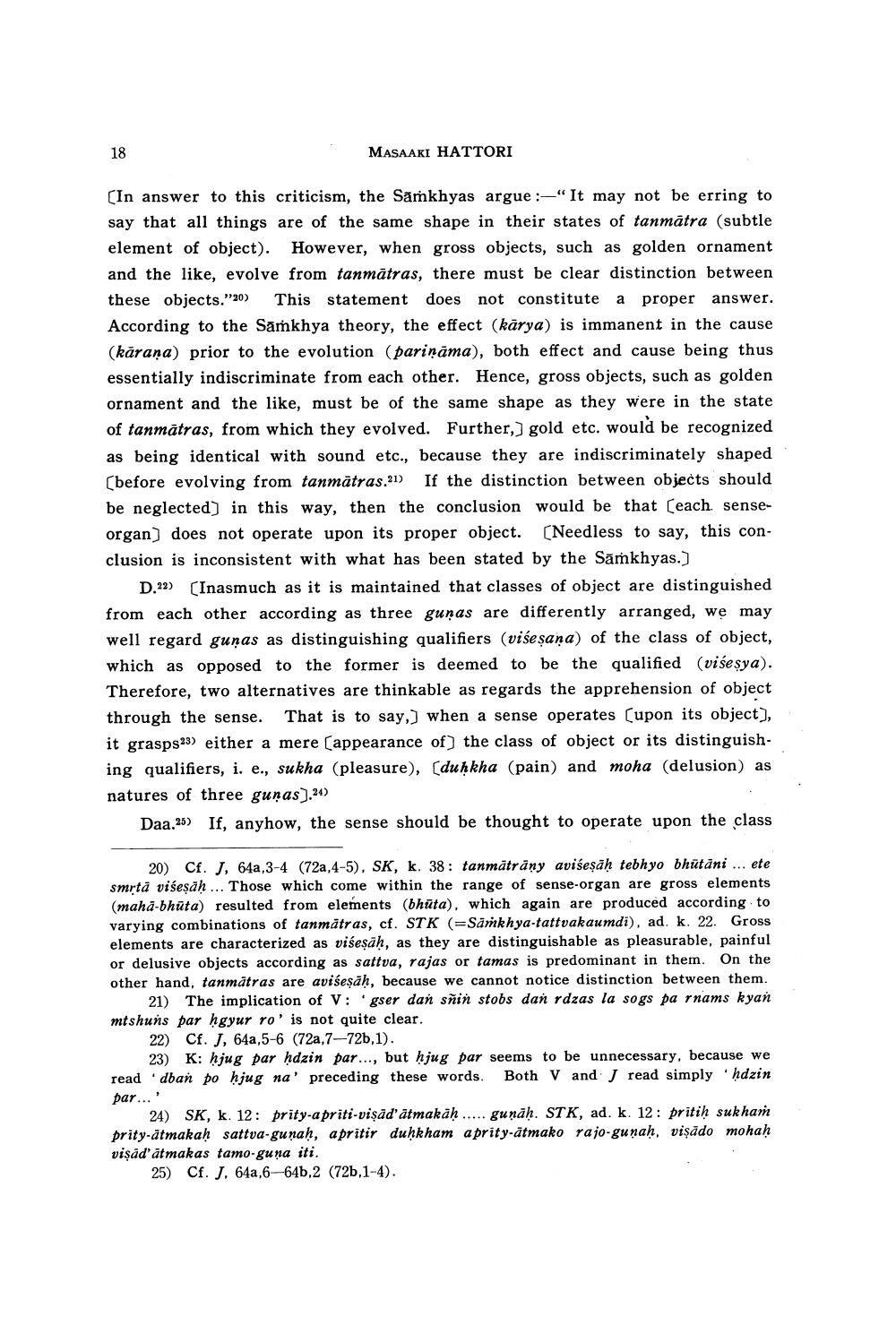________________
MASAAKI HATTORI
(In answer to this criticism, the Samkhyas argue :-“It may not be erring to say that all things are of the same shape in their states of tanmātra (subtle element of object). However, when gross objects, such as golden ornament and the like, evolve from tanmātras, there must be clear distinction between these objects."20) This statement does not constitute a proper answer. According to the Samkhya theory, the effect (kārya) is immanent in the cause (kārana) prior to the evolution (pariņāma), both effect and cause being thus essentially indiscriminate from each other. Hence, gross objects, such as golden ornament and the like, must be of the same shape as they were in the state of tanmätras, from which they evolved. Further,) gold etc. would be recognized as being identical with sound etc., because they are indiscriminately shaped (before evolving from tanmätras.21) If the distinction between objects should be neglected) in this way, then the conclusion would be that (each senseorgan) does not operate upon its proper object. (Needless to say, this conclusion is inconsistent with what has been stated by the Samkhyas.)
D.22) (Inasmuch as it is maintained that classes of object are distinguished from each other according as three gunas are differently arranged, we may well regard gunas as distinguishing qualifiers (više șana) of the class of object, which as opposed to the former is deemed to be the qualified (visesya). Therefore, two alternatives are thinkable as regards the apprehension of object through the sense. That is to say,) when a sense operates (upon its object), it grasps23) either a mere (appearance of) the class of object or its distinguishing qualifiers, i. e., sukha (pleasure), (duḥkha (pain) and moha (delusion) as natures of three gunas). 24)
Daa.25) If, anyhow, the sense should be thought to operate upon the class
20) Cf. J, 64a,3-4 (72a,4-5). SK, k. 38: tanmatrany aviseşāḥ tebhyo bhūtāni ... ete smrtă viseșah ... Those which come within the range of sense-organ are gross elements (maha-bhūta) resulted from elements (bhūta), which again are produced according to varying combinations of tanmatras, cf. STK (=Samkhya-tattvakaumdi). ad. k. 22Gross elements are characterized as viśeşāh, as they are distinguishable as pleasurable, painful or delusive objects according as sattva, rajas or tamas is predominant in them. On the other hand, tanmatras are aviseşaḥ, because we cannot notice distinction between them.
21) The implication of V: gser dan sñin stobs dan rdzas la sogs pa rnams kyan mtshuns par hgyur ro' is not quite clear.
22) Cf. J, 64a,5-6 (72a, 7-726,1).
23) K: hjug par hdzin par..., but hjug par seems to be unnecessary, because we read 'dban po hjug na' preceding these words. Both V and I read simply · dzin par...'
24) SK, k. 12: prity-a priti-vişăd'atmakāḥ ..... gunah. STK, ad. k. 12: pritih sukham prity-atmakaḥ sattva-gunah, a pritir duḥkham aprity-atmako rajo-gunah. visado mohaḥ visādātmakas tamo-guna iti.
25) Cf. J. 64a, 6-646,2 (72b,1-4).




